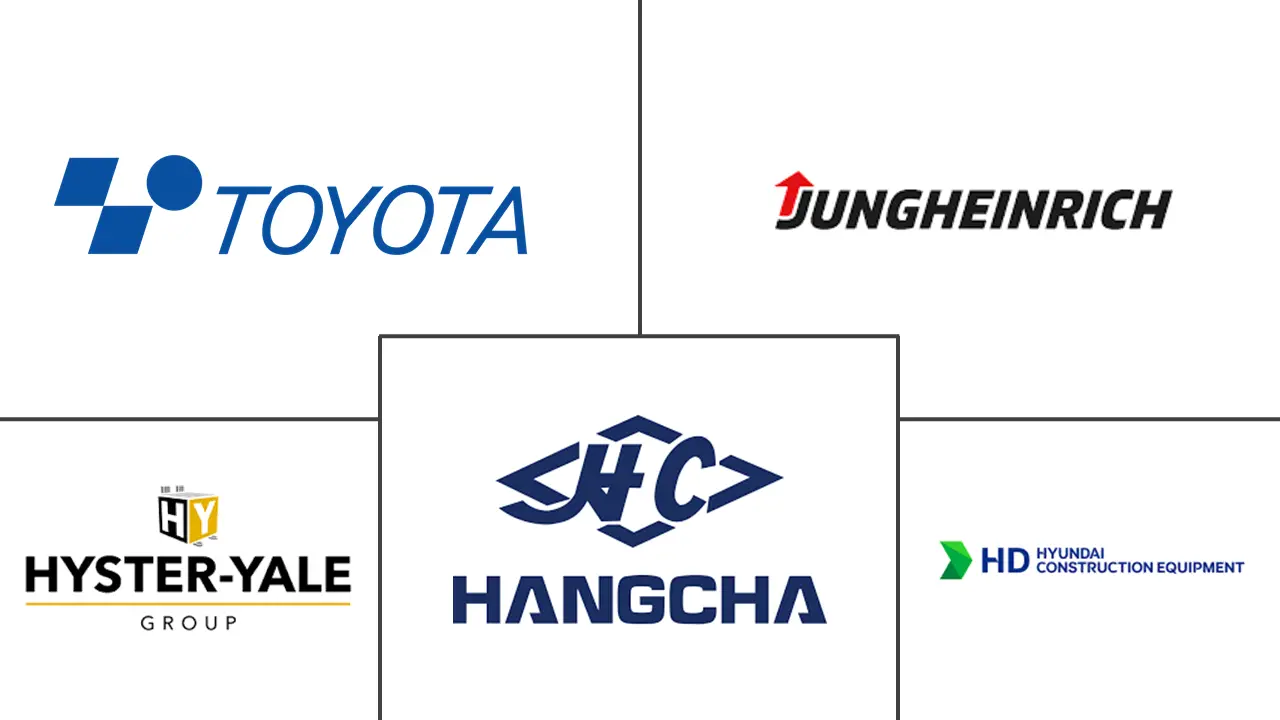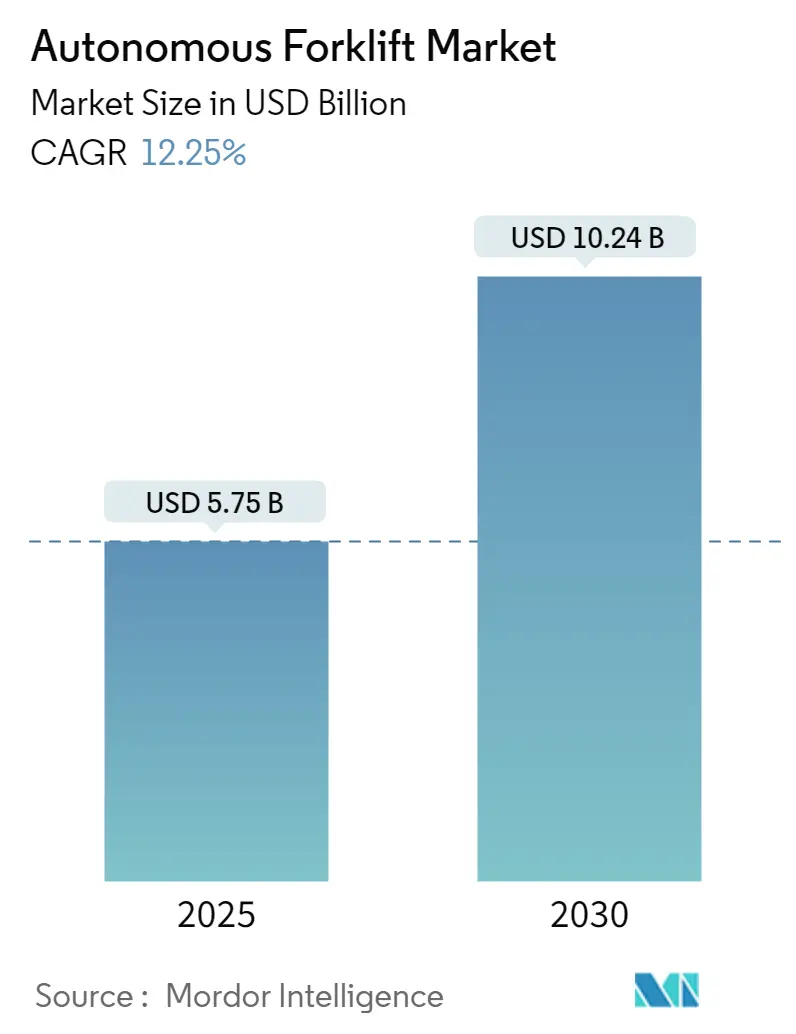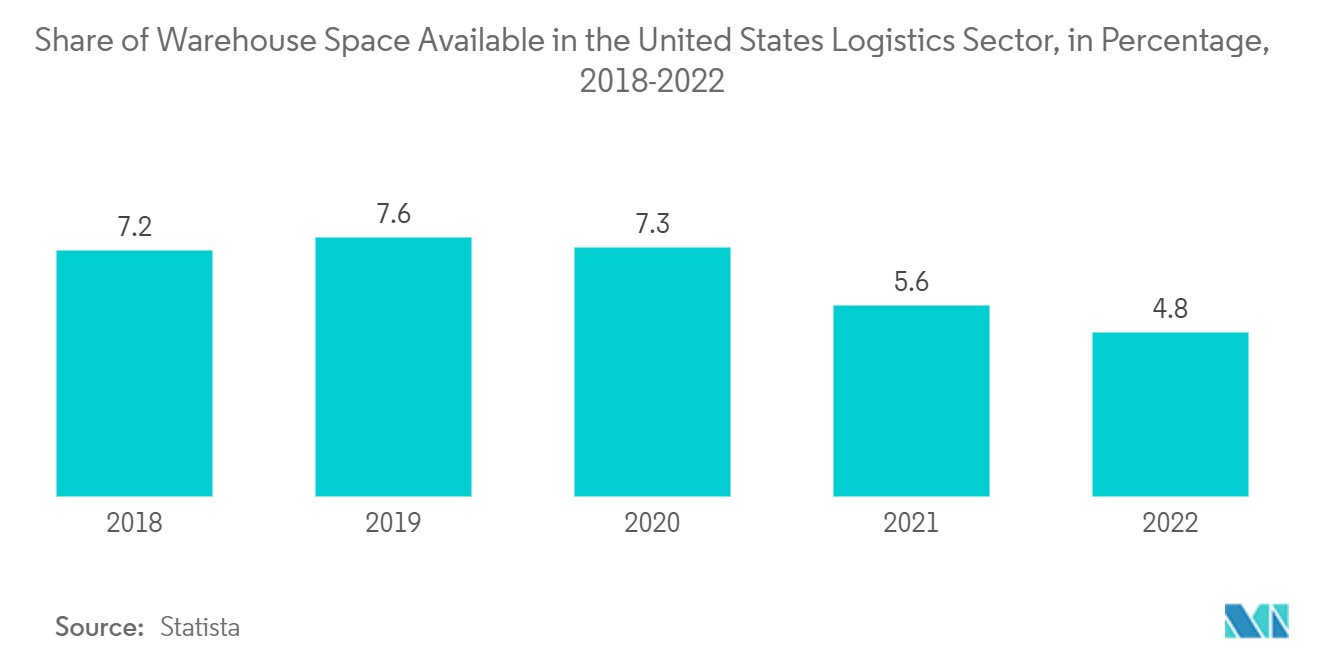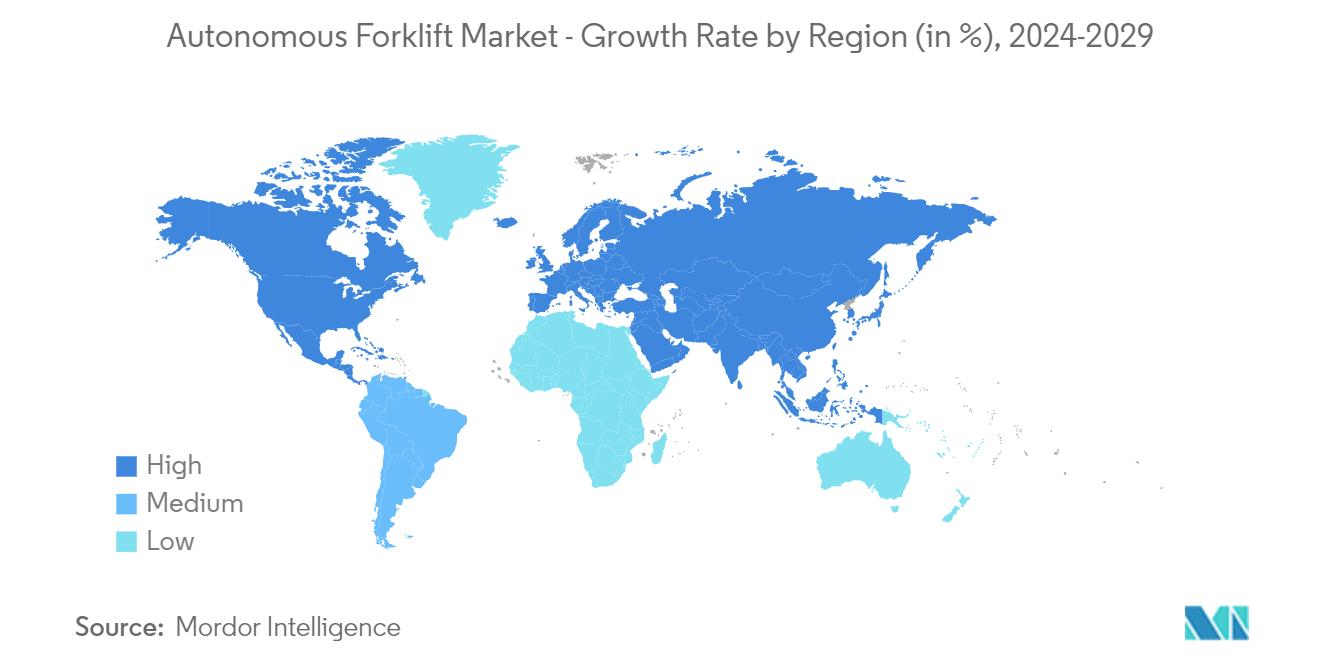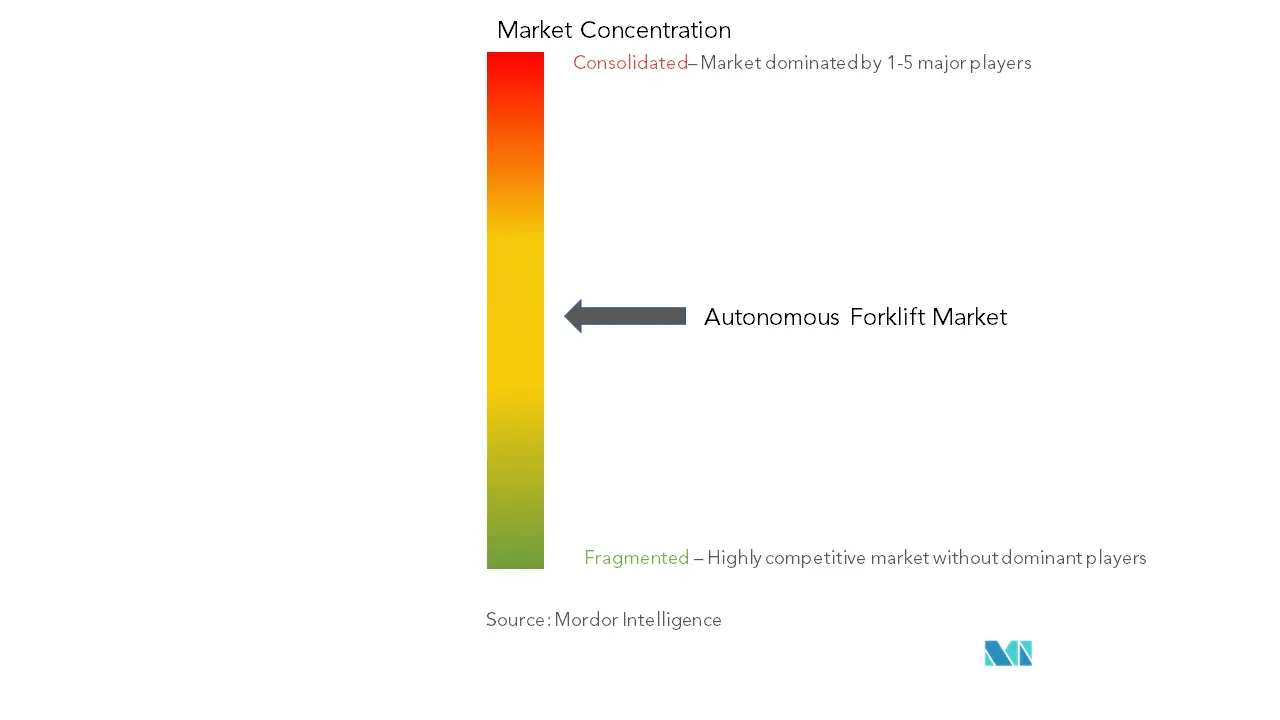Autonomous Forklift Market Analysis
The Autonomous Forklift Market size is estimated at USD 5.75 billion in 2025, and is expected to reach USD 10.24 billion by 2030, at a CAGR of 12.25% during the forecast period (2025-2030).
The expanding e-commerce sector worldwide, coupled with the increasing preference of consumers for online shopping, is expected to lead to the surging demand for autonomous forklifts in warehouses and distribution centers, thereby positively impacting the growth of the market. Moreover, the emergence of automated warehousing solutions that assist operators in reducing their operational costs is serving as a major catalyst for the demand for autonomous forklifts worldwide.
- The United States, the United Kingdom, and Ireland were the leading countries worldwide, and consumers stated that they prefer shopping online compared to traditional in-store visits as of 2023. The share of consumers that prefer to shop mostly from online mediums reached 43% in the United States in 2023, followed by the United Kingdom with a share of 35% during the same period.
- Further, the take-up of warehouse space of over five thousand square meters in European cities such as Madrid and Berlin recorded an increase in 2022 compared to 2021. The take-up of warehouse space in Madrid touched 1,300 thousand square meters in 2022 compared to 1,100 thousand square meters in 2021, while the take-up of space in Berling stood at 880 thousand square meters in 2022 compared to 400 thousand square meters in 2021.
These e-commerce companies need to efficiently manage their inventory and are required to deliver products on time, which calls for the deployment of advanced machinery, such as autonomous forklifts, in these centers. Apart from the warehousing sector, autonomous forklifts find their potential use case in various other industries, such as retail and manufacturing for transporting materials, loading/unloading materials, and other tasks.
The integration of several players in the ecosystem offering cutting-edge technological solutions is a major driver for the growth of the market worldwide. These players are incorporating state-of-the-art navigation technology to maximize the efficiency of the product being offered to their customers. Moreover, these players are constantly engaging in launching advanced driverless forklifts to enhance their brand presence and capture a greater market share.
- In March 2023, ForwardX Robotics, a global autonomous mobile robot (AMR) and warehouse solutions provider, introduced its autonomous forklift model, Apex C1500-L, featuring a payload capacity of 3,306 lbs and ensures ±2.3 in pallet placement precision. The new forklift model further enhances ForwardX's capabilities in pallet movement workflows with a higher payload capacity and the ability to work with both GMA and Euro pallets.
As the warehousing industry faces difficulties in hiring and retaining forklift operators and warehouse employees in general, automated warehouses and automated equipment have been gaining traction across the world. The deployment of autonomous forklifts on-site substantially reduces operational time, allowing operators to help bridge the labor shortage gap by empowering a single worker to handle up to 6 or 8 trailers (un)loading robots. The adoption of autonomous forklifts in the European region has witnessed a significant surge in recent years, owing to the presence of various manufacturers operating in the region.
Autonomous Forklift Market Trends
The Logistics and Warehousing Sector is Expected to Gain Traction Between 2024 and 2029
Increasing internet and smartphone penetration rates worldwide are assisting consumers in availing online mediums for daily purchases of essential products and groceries, which, in turn, is contributing to the growth of the e-commerce market. Therefore, there exists a massive demand for equipment and machinery deployed in warehousing and distribution centers that can help operators manage inventories and expedite the delivery process.
- According to the Indian Brand Equity Foundation (IBEF), India gained 125 million online shoppers between 2020 and 2023, with another 80 million online shoppers being expected by 2025.
- The number of e-commerce users in the United States touched 240.7 million in 2022 compared to 223.76 million in 2021, representing a Y-o-Y growth of 7.57% between 2021 and 2022.
- Similarly, the number of e-commerce users in Italy reached 22.04 million in 2022 compared to 19.98 million in 2021, recording a Y-o-Y growth of 10.3% between 2021 and 2022.
With the expanding e-commerce sector, there remains a massive demand for storage and warehousing facilities to ensure that products are being managed and disbursed promptly, which, in turn, positively impacts the demand for autonomous forklifts. The benefit of deploying driverless forklifts in these facilities is that they help in completing the overall loading/unloading process at a faster rate compared to traditional products. In recent years, owing to the shifting consumers' preference for availing eco-friendly products, the penetration of electric autonomous forklift rentals is witnessing surging growth.
- The industrial and logistics real estate investment in the Netherlands stood at EUR 5,150 million (USD 5,611 million) in 2022 compared to EUR 4,710 million (USD 5,131 million) in 2021, representing a Y-o-Y growth of 9.35%.
Further, the share of ready-to-occupy logistics space in the United States has decreased substantially in recent years, showcasing strong warehousing demand. In the last quarter of 2022, the availability of industrial and logistics real estate stood at 4.4%, down from 7.4% in Q4 2022.
Both the private and public players in the ecosystem are investing hefty sums in developing and expanding warehousing facilities worldwide, which is leading to the surging demand for advanced equipment, such as autonomous forklifts, that are to be deployed in these sites. Therefore, with the rising demand for warehousing facilities and the expanding e-commerce sector, there will exist a massive demand for autonomous forklifts between 2024 and 2029.
Asia-Pacific is Expected to be the Fastest Growing Market Between 2024 and 2029
Rising investments in construction projects, the expanding e-commerce and warehousing sector in the region, and growing industrial activities contribute to the demand for an autonomous forklift market in Asia-Pacific since these are extensively deployed on-site for transporting materials and loading/unloading products and commodities.
- In January 2024, Groundwork announced the commencement of construction of the largest Multimodal Logistics Park (MMLP) in South India on the northern outskirts of Bengaluru to provide a host of logistics, warehousing, and cold storage facilities that are aimed at reducing overall logistics costs from 13% to 9% making exports competitive. Further, the company stated that the logistics park will be spread across 400 acres and will have the capacity to handle 30 million metric tonnes of cargo by 2070.
- Mumbai, Chennai, and Delhi were the leading cities in India with the highest existing stock for warehousing in 2022. In Mumbai, the existing stock for warehousing touched 14.6 million square meters in 2022, followed by Delhi NCR, wherein the existing stock stood at 6.4 million square meters during the same period.
- According to the Japanese Ministry of Land, Infrastructure, Transport, and Tourism (MLIT), the area of class 1 to 3 regular warehouses in Japan reached 66.13 million square meters in 2022 compared to 61.61 million square meters in 2021, representing a Y-o-Y growth of 7.33% between 2021 and 2022.
The e-commerce sector in Asia-Pacific is expected to witness a rapid surge in the coming years, and therefore, operators in the region are extensively strategizing to expand their fleet to include advanced forklifts, which, in turn, is positively impacting the demand for autonomous forklifts. Although the deployment of autonomous forklifts across Asia-Pacific is still in its nascent phase, with the lowering cost and various domestic players integrating the ecosystem, there will exist a massive opportunity for the adoption of driverless forklifts. Apart from warehousing and distribution centers, these products are extensively utilized in industrial, manufacturing, and construction facilities for transporting materials, and hence, with the increasing government focus on enhancing the road transportation infrastructure across Asia-Pacific, the demand for autonomous forklifts is expected to showcase massive surge between 2024 and 2029.
- In December 2023, the Indian Road Transport Ministry proposed a program to build and widen around 41,000 km of national highways, including 15,000 km of high-speed (access-controlled) corridors by 2031-32 to double the average travel speed at national highways. As per the proposal, an estimated investment of INR 19.5 lakh crore (USD 234.9 billion) will be required for the completion of this project.
- In April 2023, the Chinese government announced the commencement of several new highway projects across the country. One such development project worth USD 1.07 billion will connect the Yongjing and Jingping regions, stretching 41 Km and designed to support travel speeds up to 80 Km/hr with two lanes in either direction.
Furthermore, owing to the government's aggressive focus on promoting the adoption of electric equipment in fleets, there will exist a surging demand for electric autonomous forklifts across Asia-Pacific. Companies such as BYD are collaborating with international players to integrate advanced navigation technology and sensors in their forklift products to ensure these models can be operated without manual intervention. With the increasing investments to develop and integrate cutting-edge technological solutions, the autonomous forklift market is anticipated to showcase a rapid surge from 2024 to 2029.
Autonomous Forklift Industry Overview
The autonomous forklift market is fragmented and highly competitive due to the presence of various international and domestic players operating in the ecosystem. Some of the major players include Toyota Industries Corporation, Jungheinrich AG, Hyster-Yale Group Inc., Hangcha Group Co. Ltd, HD Hyundai Construction Equipment, Balyo, Vecna AFL, Otto Motors, and Kion Group AG. These players are investing hefty sums to offer innovative automated forklift products to gain a competitive edge in the ecosystem.
- In February 2024, ArcBest announced the launch of autonomous forklifts and reach trucks equipped with software that allows human operators to control them remotely. Further, the company stated that its product utilizes sensors and cameras to navigate a warehouse floor to load and stack pallets and move other goods. The model is designed for its extensive usage at existing warehouses, distribution centers, and manufacturing facilities.
- In June 2023, Cyngn Inc. announced its partnership with BYD to facilitate the development of an autonomous forklift that will feature flexible pallet detection, which uses proprietary AI and computer vision to detect and analyze pallet dimensions in real-time, creating flexibility to work with standard, non-standard, and custom pallet sizes. As per the agreement, the forklift manufactured by BYD will be developed in conjunction with Cyngn's autonomous technology, DriveMod.
The market is anticipated to witness the integration of several new entrants in the industry who will offer advanced autonomous forklift products equipped with technologies such as telematics to enhance the convenience of fleet operators.
Autonomous Forklift Market Leaders
-
Toyota Industries Corporation
-
Jungheinrich AG
-
Hyster-Yale Group, Inc.
-
Hangcha Group Co., Ltd.
-
HD Hyundai Construction Equipment
- *Disclaimer: Major Players sorted in no particular order
Autonomous Forklift Market News
- February 2024: Seegrid Corporation announced the launch of an autonomous lift truck, the Palion Lift CR1 model, to address evolving challenges in autonomous material handling for warehousing, manufacturing, and logistics customers. The Palion Lift CR1 boasts an impressive 15’ lift height and a robust 4,000lb payload capacity. Further, the company stated that the new model is equipped with its own proprietary state-of-the-art navigation technology.
- September 2023: Worldwide Flight Services (WFS) announced the commencement of a trial to utilize automated guided vehicle (AGV) forklifts in its cargo terminal at Barcelona Airport, Spain. Further, the company stated that the trial of Linde AGV forklift trucks will be ongoing till April 2024 and, if successful, will see this technology rolled out across other WFS stations in the Europe, Middle East, Africa, and Asia (EMEAA) region.
- August 2023: Cyngn Inc., a developer of AI-powered autonomous driving solutions for industrial applications, announced a paid pre-order agreement with Arauco, a global company of sustainable forestry products, pulp, and engineered wood that is a supplier to the furniture and construction industries, to supply 100 autonomous electric DriveMod-enabled forklifts. The agreement aims to enhance Arauco's operations and drive efficiency in its material handling processes.
Autonomous Forklift Industry Segmentation
An autonomous forklift is a type of automated guided vehicle (AGV) that can carry loads along the floor of a facility without a driver onboard. The scope of the report considers pallet trucks/movers/jacks, pallet stackers, and forked automated guided vehicles, which are autonomously operated without manual intervention.
The autonomous forklift market is segmented by tonnage capacity, navigation technology, application, propulsion type, type, and geography. By tonnage capacity, the market is segmented into below 5 tons, 5-10 tons, and above 10 tons. By navigation technology, the market is segmented into laser guidance, vision guidance, optical tape guidance, magnetic guidance, inductive guidance, and others (simultaneous localization and mapping, etc.). By application, the market is segmented into logistics and warehousing, manufacturing, material handling, and others (retail, etc.). By propulsion type, the market is segmented into electric, diesel, and others (LPG, CNG, etc.). By type, the market is segmented into pallet trucks/movers/jacks, pallet stackers, and others (forked AGV, etc.). By geography, the market is segmented into North America, Europe, Asia-Pacific, and Rest of the World.
The report offers market size and forecasts for autonomous forklifts in value (USD) for all the above segments.
| By Tonnage Capacity | Below 5 Tons | ||
| 5-10 Tons | |||
| Above 10 Tons | |||
| By Navigation Technology | Laser Guidance | ||
| Vision Guidance | |||
| Optical Tape Guidance | |||
| Magnetic Guidance | |||
| Inductive Guidance | |||
| Others (Simultaneous Localization and Mapping, etc.) | |||
| By Application | Logistics and Warehousing | ||
| Manufacturing | |||
| Material Handling | |||
| Others (Retail, etc.) | |||
| By Propulsion Type | Electric | ||
| Diesel | |||
| Others (CNG, LPG, etc.) | |||
| By Type | Pallet Truck/Mover/Jack | ||
| Pallet Stackers | |||
| Others (Forked AGV, etc.) | |||
| By Geography | North America | United States | |
| Canada | |||
| Rest of North America | |||
| Europe | Germany | ||
| United Kingdom | |||
| France | |||
| Italy | |||
| Rest of Europe | |||
| Asia-Pacific | China | ||
| India | |||
| Japan | |||
| South Korea | |||
| Rest of Asia-Pacific | |||
| Rest of the World | South America | ||
| Middle East and Africa | |||
Autonomous Forklift Market Research FAQs
How big is the Autonomous Forklift Market?
The Autonomous Forklift Market size is expected to reach USD 5.75 billion in 2025 and grow at a CAGR of 12.25% to reach USD 10.24 billion by 2030.
What is the current Autonomous Forklift Market size?
In 2025, the Autonomous Forklift Market size is expected to reach USD 5.75 billion.
Who are the key players in Autonomous Forklift Market?
Toyota Industries Corporation, Jungheinrich AG, Hyster-Yale Group, Inc., Hangcha Group Co., Ltd. and HD Hyundai Construction Equipment are the major companies operating in the Autonomous Forklift Market.
Which is the fastest growing region in Autonomous Forklift Market?
Asia Pacific is estimated to grow at the highest CAGR over the forecast period (2025-2030).
Which region has the biggest share in Autonomous Forklift Market?
In 2025, the Europe accounts for the largest market share in Autonomous Forklift Market.
What years does this Autonomous Forklift Market cover, and what was the market size in 2024?
In 2024, the Autonomous Forklift Market size was estimated at USD 5.05 billion. The report covers the Autonomous Forklift Market historical market size for years: 2019, 2020, 2021, 2022, 2023 and 2024. The report also forecasts the Autonomous Forklift Market size for years: 2025, 2026, 2027, 2028, 2029 and 2030.
Our Best Selling Reports
Autonomous Forklift Industry Report
Statistics for the 2025 Autonomous Forklift market share, size and revenue growth rate, created by Mordor Intelligence™ Industry Reports. Autonomous Forklift analysis includes a market forecast outlook for 2025 to 2030 and historical overview. Get a sample of this industry analysis as a free report PDF download.

